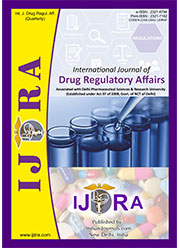Research on Quality Control Strategy of CAR-T Cell Therapy Products based on QbD
Abstract
Objective: This paper aims to provide reference for how to use the concept and method of QbD to control the quality of CAR-T cell therapy products in the commercial production of CAR-T cell therapy products in China, and how to formulate reasonable and effective quality control strategies.
Methods: This paper systematically analyzes the industrial development of CAR-T cell therapy products and the concept, application methods and implementation process of QbD in China through literature research and case analysis theory
Results: Cell therapy products are a hot area in the research and development of new drugs, but at present, there are no specific regulatory rules in the commercial production of CAR-T cell therapy products in China, the awareness of risk control is weak, and the quality control is unstable, making patients face many risks.
Conclusion: Based on the concept of QbD, the quality control strategy of CAR-T cell therapy products was proposed from three dimensions.
Downloads
References
2. Shufang Meng, Yan Huo, Tiantian Hou, et al. The key points of quality control research and non clinical research of CAR-T cell therapy products. Chinese Pharmaceutical Affairs. 2018;32(06):831-852.
3. Guiding Principles for Research and Evaluation Technology of Cell Therapy Products (Trial) [Internet]. China: NMPA; 2017 Dec 22 [cited 2022 Nov 18]. Available from:
https://www.nmpa.gov.cn/xxgk/zhcjd/zhcjdyp/20171222145901282.html
4. Yuwei Diao, Yi Liang. Management of Cell Therapy Products in Japan and Its Implications for China. Progress in Pharmaceutical Sciences. 2019;43(12):908-913.
5. Jianxin Tan, Lingli Yu, Chong Wang. An introduction to chimeric antigen receptor T cell therapy products and their current status of GMP implementation. Shanghai Medical & Pharmaceutical Journal. 2020;41(15):64-70.
6. ICH Q8: Pharmaceutical development [Internet]. China: Center for Drug Evaluation, NMPA; 2009 Aug [cited 2022 Nov 18]. Available from:
https://www.cde.org.cn/ichWeb/guideIch/toGuideIch/1/0
7. Summary Basis for Regulatory Action - KYMRIAH [Internet]. US: FDA; 2017 Aug [cited 2022 Nov 18]. Available from:
https://www.fda.gov/vaccines-blood-biologics/cellular-gene-therapy-products/kymriah-tisagenlecleucel
8. Zhong X, Liang Y. Five Critical Elements for Implementing Quality by Design. Mechanical and Electrical Information. 2011;(23):14-17+45.
9. Zhang S, He X. Industrialization progress of cellular immunotherapy and related risk factors. Biotechnology & Business. 2017;(05):21-26.
10. Chen G. Design of process layout and plant facilities for the production of cell therapy products. Shanghai Medical & Pharmaceutical Journal. 2019; 40(09):71-73.
11. Wang L. CAR-T and immunocellular tumor therapy. Chinese Journal of Cell Biology. 2019; 41(04):540-548.
12. Chen F. GPM Workshop Design of Cell Therapy Products (CAR-T). Scientific and technological wind. 2020; (17):8+16.
13. Yonghong Li, Yan Huo, Lei Yu, et al. Quality Control and Nonclinical Research on CAR-T Cell Products: General Principles and Key Issues. Engineering. 2019;5(01):263-283.
14. Bravery CA, Carmen J, Fong T, et al. Potency assay development for cellular therapy products: an ISCT review of the requirements and experiences in the industry. Cytotherapy. 2013;15(1):9-19.

This work is licensed under a Creative Commons Attribution-NonCommercial 4.0 International License.
The International Journal of Drug Regulatory affairs require a formal written transfer of copyright from the author(s) for each article published. We therefore ask you to complete and return this form, retaining a copy for your records. Your cooperation is essential and appreciated. Any delay will result in a delay in publication.
I/we have read and agree with the terms and conditions stated Page 2 of this agreement and I/we hereby confirm the transfer of all copyrights in and relating to the above-named manuscript, in all forms and media, now or hereafter known, to the International Journal of Drug Regulatory affairs, effective from the date stated below. I/we acknowledge that the IJDRA is relying on this agreement in publishing the above-named manuscript. However, this agreement will be null and void if the manuscript is not published in the IJDRA.
Download link for COPYRIGHT FORM







